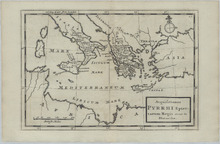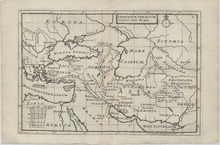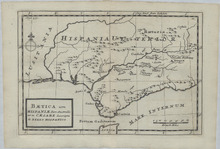Detailed copper engraved historic map showing the extension of the Persian Empire under Cyrus the Great. The map depicts modern-day Turkey, Cyprus, Greece, Crimean Peninsula, Ukraine, Syria, Lebanon, Israel, Armenia, Egypt, Arabian Peninsula, Iran, Iraq, and Northwestern India. The map is filled with a lot of geographical details concerning place names in Latin, Rivers, Lakes, Mountains, and Islands. The title is inside a simple cartouche. Citeis, Regions, Rivers, and Islands shown are: Europa (Europe), Tanais F. (Don River, Russia), Palus Maeotis (Sea of Azov or Maeotian Marshes/Maeotian Lake, Ukraine/Russia), Scythia, Ister F. (Danube River, Europe), Rha F. (Volga River, Russia), Illiricum (Roman Province of Modern-Day Albania, Croatia, Bosnia and Herzegovina, Montenegro and Serbia), Thracia (Roman Province of Modern-Day Bulgaria, Greece, and Turkey), Macedonia, Graecia (Greece), Epirus (Modern-Day parts of Albania and Greece), Asia Minor (Turkey), Phrygia (Turkey) Aegeum Mare (Aegean Sea), Caystrus F., Cuma (Cyme), Larissa (Ancient city destroyed in 279 BC), Sardes (Sart), Paetolus F., Caria, Lycia (Modern-Day parts of Antalya and Muğla), Pamphylia (Modern-Day Antalya), Cilicia, Piteria (Pteria ancient capital of the Assyrians destroyed in 547 BC), Paphalagonia, Cappadocia (Nevşehir), Halis F. (Kızılırmak River), Caucasus M. (Caucasus Mountains), Colchis, Phasis F. (Rioni River), Albania (Part of Modern-Day Azerbaijan and Dagestan), Armenia, Creta (Crete), Mare Mediterraneum (Mediterranean Sea), Libya, Barce (Marj), Cyrene (Ancient City destroyed by an Earthquake in 365 AD), Aegyptus (Egypt), Nilus F. (Nile River), Africa, Cyprus, Syria, Phoenice, Sinus Arabicus (Red Sea), Taurus M. (Taurus Mountains), Tigris F. (Tigris River), Euphrates F. (Euphrates River), Assyria (Northern Iraq, Northeast Syria, and Southeastern Turkey), Ninus (Nineveh), Mesopotamia (Iraq, Kuwait, Northeastern Syria, Southeastern Turkey, and Southwestern Iran), Babylon (Hillah), Babylonia (Iraq), Chaldaea, Arabia, Araxes F. (Aras River), Cadusci, Media (Northwestern Iran), Ecbatana (Hamedan), Susa (Shush), Susiana (Elam in West and Southwest Iran), Sinus Persicus (Persian Gulf), Persia (Iran), Persepolis, Cissii, Hyrcania (Parts of Modern-Day Northern Iran and Turkmenistan), Parthia (Northeastern Iran), Asia, Mardi, Carmania Deserta, Carmania (Kerman Province, Iran), Mare Erythraeum (Erythraean Sea), Gedrosia (Balochistan), Indus F. (Indus River), India, Arachosia (Modern-Day Southern Afghanistan and Pakistan), Aria (Northwest Afghanistan), Drangiana (Modern-Day Iran, Afghanistan, and Pakistan), Parapamisus, Bactriana (Northern Afghanistan), Mare Caspium (Caspian Sea), Caspii, Iaxartes F. (Syr Darya River), Sacae, Sogdiana (Tajikistan and Uzbekistan), Margiana (Afghanistan and Turkmenistan), and Oxus F. (Amu Darya River) The source publication is: Geographia antique, Latinorum et Graecorum, tabulis XXXII novis & accuratis expressa, translated: Thirty-two new and accurate maps of the geography of the ancients, as contained in the Greek and Latin Classics. It was printed and sold in 1739 in London by Thomas Bowles. Herman Moll was a Dutchman bookseller, geographer and engraver. Around 1678 he moved to London where for a while he continued as an engraver. Later, he started his own businesses a map publisher and by the turn of the century had become the most prominent map publisher in the country. He published atlases and loose maps of all parts of the world many of which were highly decorative. In 1724 he published his 'New Description of England and Wales', an atlas of the English and Welsh Counties. He had many interesting friends including Daniel Defoe, Jonathan Swift (for whom he provided maps for Robinson Crusoe and Gulliver's Travels), explorers William Damier and Woodes Rogers, and the scientist Robert Hooke.



